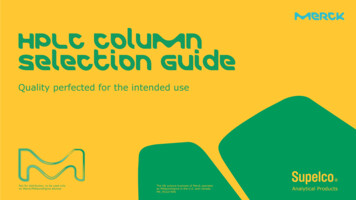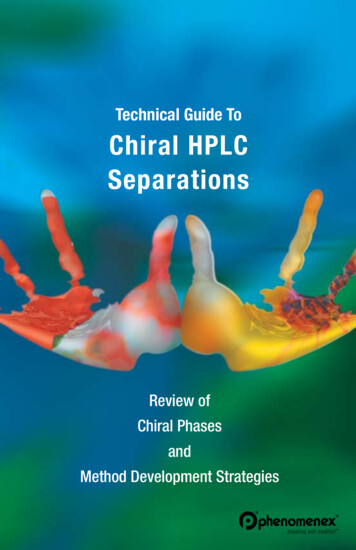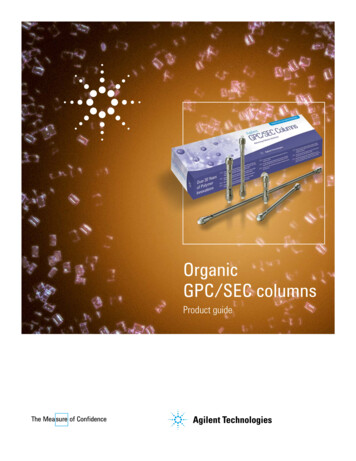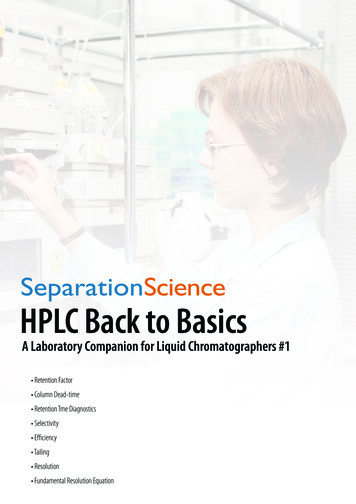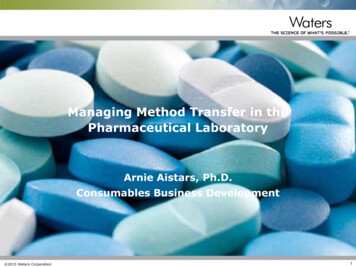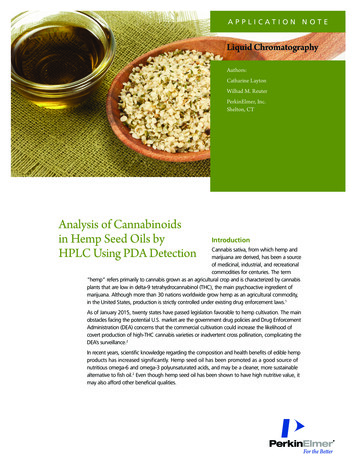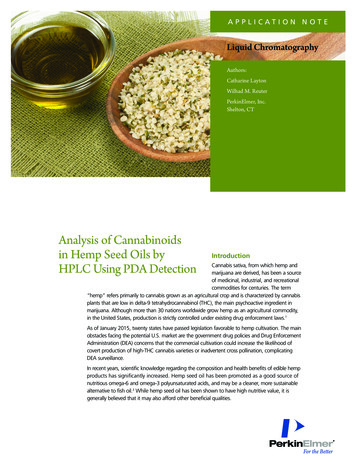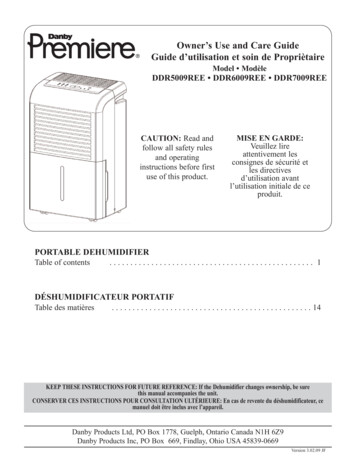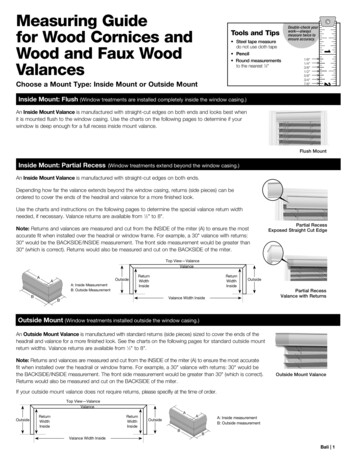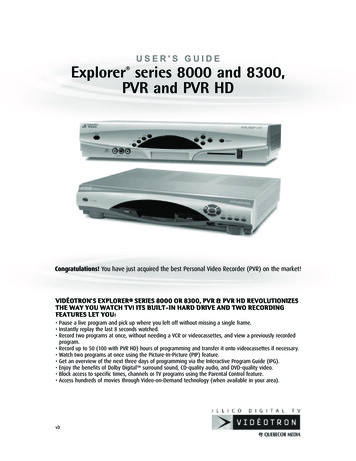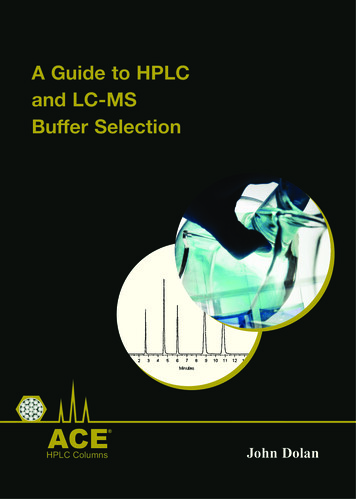
Transcription
A Guide to HPLCand LC-MSBuffer SelectionHPLC ColumnsJohn Dolan
Your decision has lasting effects.Choose wisely.HPLC ColumnsUltra Inert Base-Deactivated HPLC ColumnsFor Performance, Selectivityand Guaranteed ReproducibilityACE performanceguaranteeIf ACE does not outperform your existing column (of equivalent phase,particle size and dimensions), send in your comparative data within 60days and keep the ACE column FREE OF CHARGE.
Using Buffers with HPLC and LC-MSTable of ContentsPageWhy Control pH?2Practical Implications4Controlling pH4What about LC-MS?6Just Interested in Low pH?7Or High pH?7How Much?7Solubility Issues10Dilution Effects11Buffer .ace-hplc.com
Using Buffers with HPLC and LC-MSWhen samples contain ionizable compounds, the mobile phase pH can be one ofthe most important variables in the control of retention in a reversed-phaseHPLC (RP-HPLC) separation. However, if it is not controlled properly, pH canbe a source of many problems. Since most compounds analyzed by RP-HPLCcontain one or more acidic or basic functional groups, most mobile phasesrequire pH control. For this reason, buffers are widely used. This booklethighlights some of the important aspects of mobile phase pH for the practicalchromatographer.Why Control pH?Figure 1 illustrates the need for pH control when ionizable compounds arepresent. When an acid is more than 2 pH units above or below its pKa, it will be 99% ionized or non-ionized, respectively. Bases are ionized below their pKa andnon-ionized above their pKa. The non-ionized form will be less polar (morehydrophobic), and thus more strongly retained in a reversed-phase system. Thus,at low pH, acids will be more retained (Fig. 1a), whereas bases will be moreretained at high pH (Fig. 1b).Figure 1. Retention vs. pH for a hypothetical acid (a) and base (b).If the mobile phase pH is near the pKa, you can see that small changes in pH canmake large changes in retention – not what is desired for a robust separation.This is illustrated in Figure 2a, which shows the extreme sensitivity of somecompounds to very small changes in pH. Here the resolution changes by a factorof two for a change of only 0.1 pH units – this is the amount of error in pHadjustment common to many laboratories. Figure 2b represents a plot ofretention vs. pH for an acid, a base and a neutral compound. At pH 5, retentionis less sensitive to pH than it is at pH 3 (for the acid) or pH 6 for the base.2www.ace-hplc.com
Besides the instability of retention times when the pH is near the pKa, relativepeak spacing (selectivity) can change if compounds of similar structure arepresent.(a)(b)Figure 2. The effect of small changes in mobile phase pH on the separation.(a) Basic analytes: p-anisidine, m-toluidine, 4-chloroaniline, 3-aminobenzonitrile (inretention order); 27:73 methanol/phosphate buffer.(b) Acid: salicylic acid; base: methylamphetamine; neutral: phenacetin.Another factor that should be considered when choosing the mobile phase pH isthe stability of the column. As a general rule, silica-based columns should beoperated at 2 pH 8. At pH 2, bonded phase loss due to hydrolysis can occur.Above pH 8, the silica backbone becomes increasingly soluble. Higher-puritysilica tends to tolerate high pH better than lower-purity products. A furthercomplicating matter is the potential for ionization of unbonded silanol (-Si-OH)groups on the surface of the silica particle. For older, less-pure silica (oftenreferred to as “Type-A” silica), the pKa of these silanol groups is in the pH 4-5region. This means that at pH 6, significant silanol ionization can occur for thesematerials. Historically, this has been the major cause of peak tailing for basiccompounds through cation exchange processes. The newer, high-purity(“Type-B”) silica has a pKa 7, so peak tailing due to cation exchange withionized silanol sites is minimal. This is one reason why high-purity silicas givemuch better peak shape for bases than their older counterparts, as is illustrateddramatically for several basic components in the separations shown in Figure 3. Inaddition to peak shape improvement, the use of high purity silica leads toimproved reproducibility compared to low purity silica due to the reduction ofthese unpredictable secondary silanol interactions.www.ace-hplc.com3
Figure 3. The effectiveness of high purity silica in reduction of silanol tailing of bases.Components: norephedrine, nortriptyline, toluene (neutral), imipramine, amitriptyline.Conditions: 250 x 4.6mm, 5µm columns; 80:20 methanol/25 mM phosphate (pH 6.0);1.00mL/minPractical ImplicationsThe characteristics of the column and of samples in general, lead to arecommendation to start method development with a mobile phase in the pH 2-3range. At this pH, the ionization of most organic acids will be suppressed, aswill the ionization of any silanol groups on the column. Bases will be ionizedunder these conditions, but the pKa of most basic compounds is 7, so operatingat a sufficiently high pH to suppress ionization will be detrimental to mostcolumns. So, all other things being equal, it is best to start out at a low pH. Ifyou need to operate the column at a high pH, be sure to select a column knownto be stable in the pH region you choose.If low-pH ion suppression does not provide acceptable results, the mobile phasepH can be adjusted to help obtain the desirable separation. It usually is mostfruitful to adjust the mobile phase organic content (%B-solvent) to obtainacceptable retention for neutral and non-ionized compounds, then to adjust thepH to fine-tune retention of ionic analytes.Controlling pHSince the retention of ionizable compounds is very sensitive to the mobile phasepH, it is necessary to control the pH of the mobile phase by the addition of abuffer. A buffer maintains the pH when a small amount of acid or base is added.Many different substances have been used for buffering in HPLC; some of these4www.ace-hplc.com
additives are listed in Table 1. A buffer is most effective when used within 1 pHunit of its pKa, but may provide adequate buffering 2 pH units from the pKa.Table 1. pKa Values of Common Mobile Phase Additives1pKa (25 .259.7810.3310.7211.2712.33compoundtrifluoroacetic acid2phosphoric acid (pK1)citric acid (pK1)formic acidacetic acidcitric acid (pK2)propionic acidcarbonic acid (pK1)citric acid (pK3)phosphoric acid (pK2)trisboric acidammoniaglycine (pK2)carbonic acid (pK2)triethylaminepyrrolidine3phosphoric acid (pK3)1data of [1]; 2 Merck Index; 3 CRC Handbookof Chemistry and PhysicsThe most popular buffers for HPLC with UV detection are phosphate andacetate. Phosphate and acetate are particularly useful buffers because they canbe used at wavelengths below 220 nm. As can be seen from Table 2, phosphatehas three pKa values that give it three buffering ranges: 1.1 pH 3.1,6.2 pH 8.2, and 11.3 pH 13.3 (allowing for buffering of pKa 1 pH units).Practical limits of column stability require that we truncate the lower range to2.0 pH 3.1 and eliminate the highest range. Notice that there is a gap inbuffering between pH 3.1 and pH 6.2 for phosphate. This means that, althoughit is possible to adjust the pH of phosphate to 5.0, there is negligible bufferingcapacity at this pH. To fill this buffering gap, another buffer is needed.Fortuitously, acetate fills this need well, with a buffering range of 3.8 pH 5.8.With a slight extension of the buffering range from 1 pH units from the pKa,phosphate and acetate can cover the entire pH range of 2 pH 8 normally used forsilica-based columns.www.ace-hplc.com5
Sometimes during method development, you may desire to have full control ofthe pH over the useful range of the column. In this case, a blend of phosphateand acetate buffer will allow continuous variation of the mobile phase from2 pH 8. Once you find the desired pH, the buffer not needed can be eliminated.For example, if the final mobile phase pH is 4.3, acetate is all that is needed, sophosphate does not need to be used at all.Some analysts like to use citrate for a buffer, because it has three overlappingpKa values that allow buffering over the 2.1 pH 6.4 range (Table 2). However,citrate does not have as low a UV-cutoff as acetate and phosphate, so work atwavelengths below 220 nm is not possible; in addition, some analysts find thatthey have more problems with check valves when citrate is used. So citratebuffer usually is a second choice to phosphate and acetate.Table 2. Common HPLC Buffersbufferphosphate (pK1)phosphate (pK2)phosphate (pK3)acetate1citrate (pK1)citrate (pK2)citrate (pK3)trifluoroacetic acid (0.1%)phosphoric acid (0.1%)formic acid (0.1%)ammonium formateammonium bicarbonateborate1pH rangeLC-MS compatible1.1 – 3.16.2 – 8.211.3 – 13.33.8 – 5.82.1 – 4.13.7 – 5.74.4 – 6.42.02.02.72.7 – 4.76.6 – 8.68.3 -10.3XXXYESXXXYESXYESYESYESYESsuitable for LC-MS as ammonium acetateWhat about LC-MS?When a mass spectrometer is used as the LC detector (LC-MS), the mobilephase must be volatile, because one of the functions of the LC-MS interface is tovaporize the mobile phase. This means that the most popular buffer for LC-UVwork, phosphate, cannot be used. Ammonium acetate is sufficiently volatile forLC-MS use, but we are left with the 2.0 pH 3.8 and 5.8 pH 8.0 range tocover. Table 2 lists several additional buffers that are sufficiently volatile forLC-MS use. Ammonium formate (2.7 pH 3.7) does a fairly good job of filling6www.ace-hplc.com
the gap at the low-pH end. Ammonium bicarbonate (6.6 pH 8.6) works forhigher pH values. These do not completely cover the desired buffering ranges,but for LC-MS applications they are what are available to work with.Just Interested in Low pH?If a low-pH mobile phase is all that is important, 0.1% v/v phosphoric acid(Table 2) provides reasonable buffering at pH 2 for LC-UV applications.Trifluoroacetic acid (TFA) also generates a mobile phase pH of 2 at 0.1% v/v(Table 2), and for many years was the additive of choice for LC-MS at low pH.TFA also acts as an ion-pairing reagent, and is widely used for protein andpeptide separations. TFA, however, can suppress ionization in the LC-MSinterface, causing a drop in signal, so it has fallen out of favour in recent years.Instead, 0.1% formic acid (pH 2.7, Table 2) is the first choice for LC-MS atlow pH. With the use of an acid for low-pH, it is assumed that the pH is moreimportant than the buffering capability – if true buffering is needed, select abuffer from Table 2 that encompasses the desired pH.Or High pH?As mentioned earlier, the solubility of silica increases as the mobile phase pH isincreased above pH 8, so pH 8 generally is not recommended. However, it maybe necessary to work with higher-pH mobile phases in order to obtain thedesired separation. In such cases, you should select a column designed for workat high pH. As a general rule, high purity silica, high “carbon load” andendcapping reduce silica solubility. Phosphate buffer should be avoided,because it enhances silica dissolution at high pH. Instead use organic buffers,such as pyrrolidine, which can help extend column lifetime at high pH. Evenwith careful selection of conditions, column lifetimes at pH 8 are expected tobe shortened. Of course columns which use polymeric, rather than silica,particles are not susceptible to silica dissolution, so may be used at high pH, butsuch columns are not available in as wide a range of stationary phases as silicabased columns.How Much?One function of the buffer is to keep the analyte at the desired pH. If youconsider just this aspect of buffering, very little buffer is needed. For analyticalwork, many samples are in the µg/mL to ng/mL range. So for injections of 100µL, the mass on column will be no more than a few hundred nanograms. It takesvery little buffer, even at 1 pH unit from the pKa of the buffer, to provide all thebuffering that is needed for the sample.www.ace-hplc.com7
The buffer also must buffer the column so that it stays at constant pH. Arelatively large volume of buffered mobile phase passes through the column, sothe stationary phase is constantly exposed to buffer. Newer, high-purity silicacolumns have fewer acidic silanol groups, so they need less buffer than theolder, lower-purity silica columns. This property of the column is illustratedwith the chromatograms of Figure 4. (In this application, trifluoroacetic acidserves to keep the pH low and also acts as an ion-pairing reagent, so the twoeffects are not isolated from each other.) Note in the left column ofchromatograms that the peak shape is comparable for all three columns when0.1% TFA is added to the mobile phase. However, when the concentration ofTFA is dropped ten-fold to 0.01% as shown in the chromatograms on the right ofFigure 4, the correlation of silica purity and peak shape is obvious. The peakshape degrades slightly for the high-purity silica column when compared to thatat 0.1% TFA, but there is a dramatic change in peak shape for the moderate- andlow-purity silica columns. The only variable that has changed between the twosets of chromatograms is the concentration of TFA. It appears that the TFA acts,at least in part, to buffer the column so that the strong interactions responsible forpeak tailing are minimized. When insufficient buffer is present, peak shapesuffers on all columns. Although most new methods are developed on high-purity,Type-B silica, the level of silanol acidity may vary significantly from onemanufacturer’s product to another’s. As a safety factor, it is a good idea to usemore than the minimum amount of buffering required. This leads us torecommend acid additives in the range of about 0.1% v/v or buffers of at least5-10 mM in the final solution.A third, and perhaps most important, task of the buffer is to buffer the sample asit is injected, so that it quickly attains the mobile phase pH. It should be obviousthat the job
www.ace-hplc.com 5 additives are listed in Table 1. A buffer is most effective when used within 1 pH unit of its pKa, but may provide adequate buffering 2 pH units from the pKa. Table 1.pKa Values of Common Mobile Phase Additives1 The most popular buffers for HPLC with UV detection are phosphate and acetate. Phosphate and acetate are particularly useful buffers because they can

